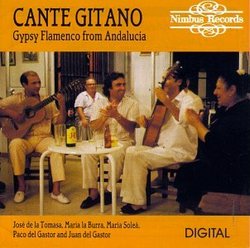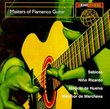| All Artists: Cante Gitano Title: Cante Gitano - Gypsy Flamenco from Andalucia Members Wishing: 1 Total Copies: 0 Label: Nimbus Records Release Date: 12/2/1992 Genres: International Music, Latin Music Styles: Europe, Continental Europe, Eastern Europe, Latin Music, Flamenco Number of Discs: 1 SwapaCD Credits: 1 UPC: 710357516825 |
Search - Cante Gitano :: Cante Gitano - Gypsy Flamenco from Andalucia
 | Cante Gitano Cante Gitano - Gypsy Flamenco from Andalucia Genres: International Music, Latin Music
|
Larger Image |
CD DetailsSimilar CDs |
CD ReviewsTraditional flamenco Music Listener | 10/30/2005 (5 out of 5 stars) "Judging from the comment made by DISAPPOINTED "N/A", it's obvious that he/she hasn't really listened much to flamenco and understood the traditional roots of the art form. If you're expecting flashy or jazzy solo guitar then forget it. But this is where flamenco started, ie. cante or singing. The live capture of cante is great and I see no reason why this should be rated poorly if people appreciate flamenco 'song' instead of focussing on flashy show-offs." Gypsy nights Onthewall | New York NY | 04/10/2007 (4 out of 5 stars) "Imagine a starry night or a smokey cafe and this music is playing. There is a whole atmospere created by this group. I wish there were sounds of Flamenco dancers tapping. This would have make the music come even more alive." Flamenco in its proper ambience Paul Magnussen | Campbell, CA USA | 04/14/2009 (5 out of 5 stars) "This album forms one of a pair on the Nimbus label (the other being Cante Flamenco). Among Nimbus's laudable qualities at this time were first-class recordings, first-class (though not necessarily famous) artists, and careful attention to acoustics.
Especially notable, however, was an almost obsessive preoccupation with performances that were whole and 'live' -- not sewn together, Frankenstein fashion, from the usable parts of corpses. In accordance with this objective, the present album presents Gypsy artists, not in the recording studio, but in a small private club in Morón de la Frontera -- with no chance of retakes! Here Nimbus were really taking to the air without a parachute, because the difficulties of producing a first-class performance to order are legendary. Artists unused to being recorded may get self-conscious and seize up; others may be jealous of each other, or too tired, or too drunk, or not drunk enough. There may be extraneous street noise, etc. All concerned here are from families illustrious in Flamenco: María la Burra is the daughter of the famous cantaor (singer) El Borrico, María Soleá is Terremoto's sister, and José de la Tomasa is from the family of Manuel Torre! Add to these the nephews of Diego del Gastor on guitars, and you aren't doing too badly. Few memorable flamenco evenings are particularly brilliant at the outset, and this disc carries on that tradition: the first track is, frankly, ropey. La Burra sings tentatively and with alarming inattention to pitch, and one of the guitars is also out of tune: in fact, singers and guitarists don't seem to mesh at all (two guitars are too many for serious Soleares* anyway). María Soleá is considerably better with her Tientos. The album really takes off with José's Seguiriya, which is outstanding, and Paco also shows why he is one of the most sought-after accompanists. From this point on, it is all good stuff, and La Burra makes a good recovery with her Tangos. The finale, a 22-minute Bulería moving about between all the participants, is terrific, the high point of the disc. For me, the stars of this album are José de la Tomasa and Paco del Gastor. The former shows not only a wide knowledge of the Cante, but sings with ease and authority. The more I hear of Paco's playing, the better I like it: his accompanying here is exemplary. The times he really lets go -- and when he does it's spot on, it lifts you out of your seat -- are when the singer is gathering his/her forces. This is as it should be -- a dialogue, not a competition. At over an hour and a quarter, this is more than double the length of some CDs, and still longer than most even if you use track selection to omit three or four numbers; hence five stars despite a few rough tracks. The booklet notes are among the best I've seen. One final thought: if the photographs do indeed, as stated, show both María la Burra and María Soleá, then they must look like identical twins -- even down to their clothing, hairstyles and jewelry. *I have capitalised the names of flamenco styles since I can't italicise them, although I wouldn't normally do so." |

 Track Listings (8) - Disc #1
Track Listings (8) - Disc #1